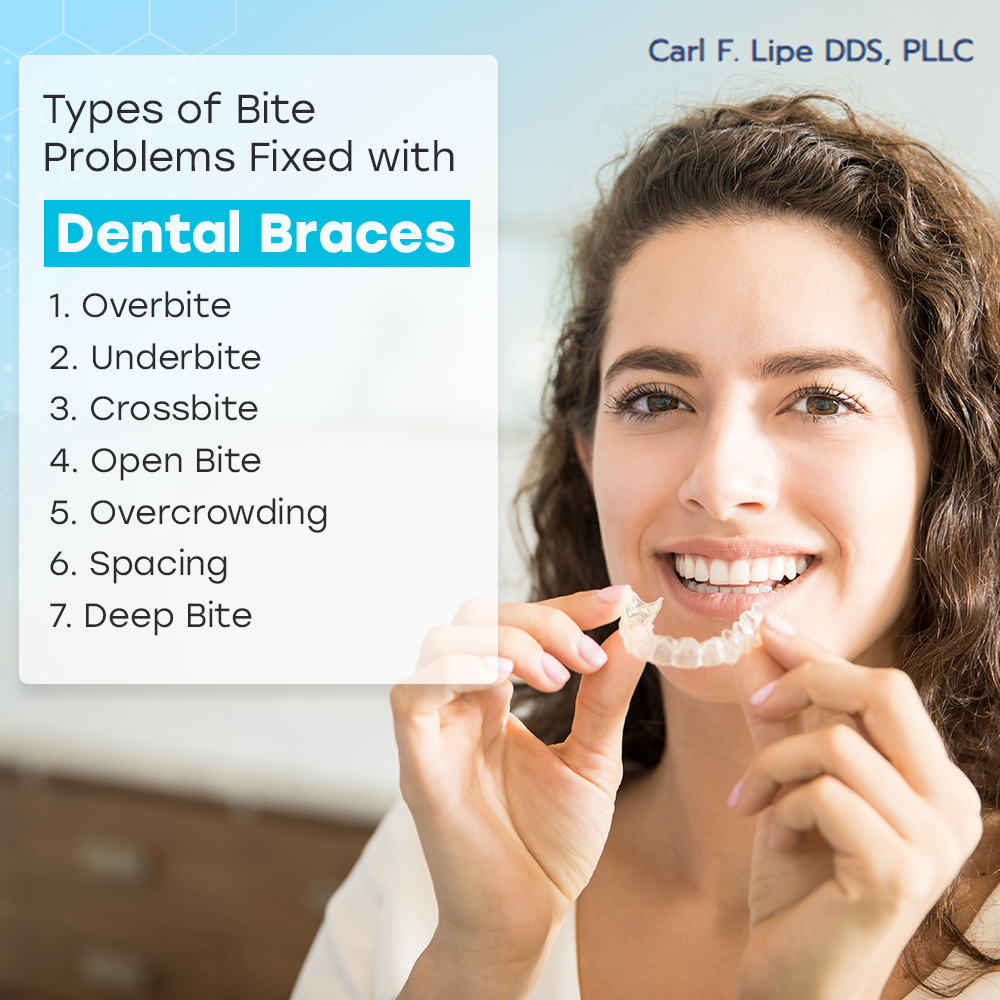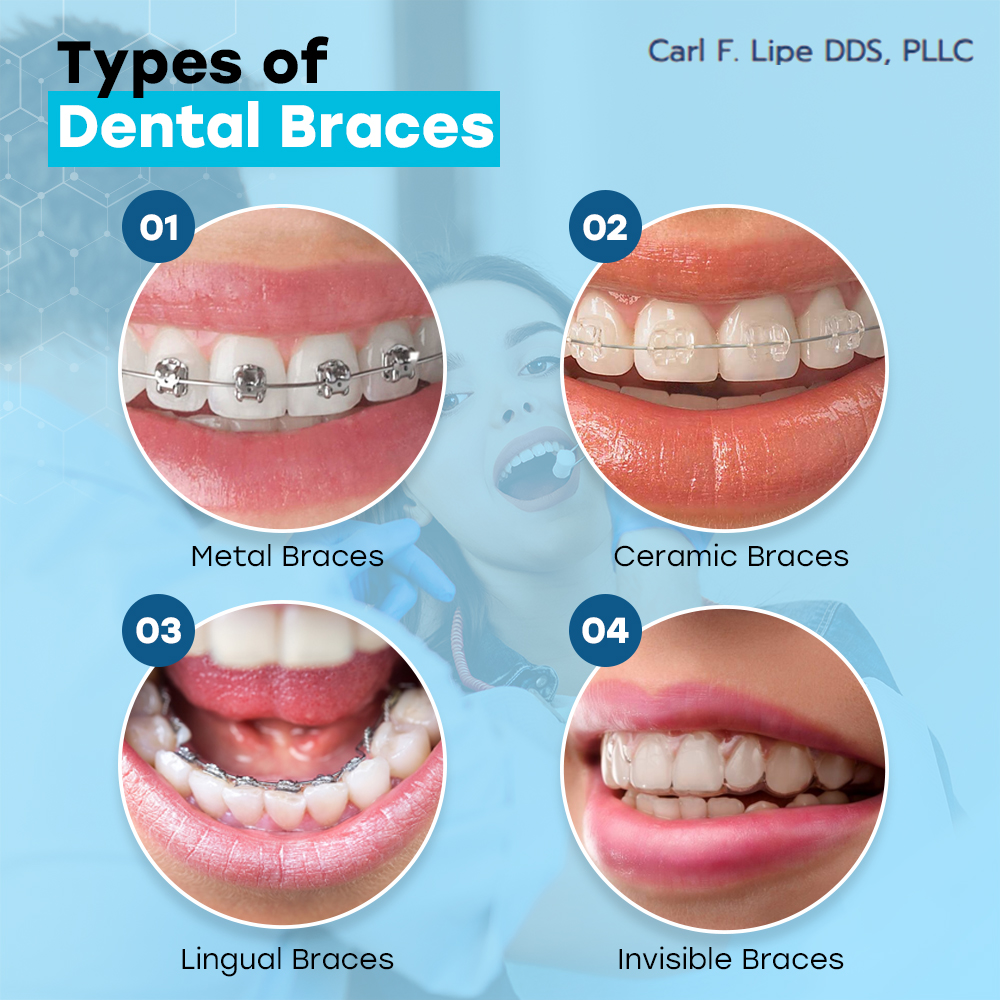Are you juggling with your crooked or crowded teeth? No worries, at Carl F. Lipe’s dental practice in Denver, we value the importance of a healthy, beautiful smile. We know that misaligned teeth can create various unwanted effects & so our expert team is committed to providing the best quality dental braces in Denver to restore your buoyant smile. Call us and schedule an appointment today!
What are Dental Braces?
Dental braces are orthodontic appliances that help fix problems of your misaligned teeth and jaws. They consist of brackets attached to the teeth and connected by wires and bands. All these components contribute to moving the teeth to their desired positions with time. At our practice, we offer a variety of braces, including traditional metal braces and ceramic braces, satisfying the unique needs of our patients seeking orthodontics in Denver.
Are Dental Braces Right for You?

Determining if braces are right for you involves an examination by our efficient orthodontists. This can address dental issues like crowded teeth, tooth gaps, underbites, overbites, and crossbites. If you are experiencing any of these conditions, dental braces are the only effective solution. Our dentists will assist you in assessing your oral health, discussing your treatment goals, and recommending the best orthodontic option for you.
How Do Dental Braces Work?
Dental braces gradually create pressure on your teeth as a result it is straightened over time. This pressure slowly moves your teeth into the proper position, as the jawbone starts to adapt to the pressure of the braces.
Our teeth are firmly rooted in their place and connected to the jawbone by the Periodontal membrane. This membrane responds to the pressure applied by braces, allowing the teeth to move.
1. Brackets
The process of getting braces begins with the application of brackets. After your teeth are cleaned and dried, brackets made from ceramic, plastic, or stainless steel are glued onto your teeth. This step may feel slightly uncomfortable, but it is not painful. The brackets serve as anchors for the wires that will move your teeth.
2. Wires and Bands
The brackets are connected by archwires, which are made from materials like stainless steel, nickel-titanium, or copper titanium. These wires apply the necessary pressure to move your teeth.
Elastic bands, also known as O-rings or ligatures, are then placed around the brackets to add extra pressure and help guide the teeth into place.
3. Spacers
In some cases, spacers are used to create room for the braces. These small rubber or metal rings are placed between your molars. Spacers push your molars apart to make space for the bands that will fit around them. Not everyone needs spacers, and they are typically only used for a week or two.
4. Buccal Tubes
A buccal tube is a small metal part that can be attached to one of your molars. This tube acts as an anchor for the braces, holding the wires securely in place. Your orthodontist can adjust the buccal tube to tighten or loosen the braces as needed.
5. Springs
Coil springs may also be used on the archwire to apply pressure between two teeth, creating space between them. This is particularly useful when teeth are crowded and need to be moved apart.
6. Headgear
In rare cases, additional pressure is needed to correct more complex dental issues. Headgear, which is typically worn at night, attaches to your braces to provide this extra force. While headgear is not commonly used, it can be an important part of achieving the best possible results.
Types of Dental Braces

1. Metal Braces
These are traditional braces made from high-grade stainless steel.
Advantages
○ Strong and durable.
○ Typically the most cost-effective option.
○ Suitable for most orthodontic issues.
Considerations
○ Visible on the teeth.
○ May cause discomfort initially.
2. Ceramic Braces
These Braces are made from clear or tooth-colored ceramic material.
Advantages
○ Less noticeable than metal braces.
○ Blend in with natural tooth color.
○ Effective for various orthodontic treatments.
Considerations
○ Can be more expensive than metal braces.
○ Brackets can stain if not cared for properly.
○ Slightly larger than metal brackets.
3. Lingual Braces
These custom-made appliances are placed on the backside of the teeth.
Advantages
○ Completely hidden from view.
○ Highly effective for complex dental movements.
○ Effective for various orthodontic treatments.
Considerations
○ May face challenges while cleaning.
○ May cause more initial discomfort and affect speech temporarily.
○ Often more expensive than other options.
4. Invisible Braces
Clear, removable aligners made from plastic.
Advantages
○ Virtually invisible when worn.
○ Removable for eating and cleaning.
○ Comfortable with no metal components.
Considerations
○ Require discipline to wear 20-22 hours a day.
○ Not advised for severe orthodontic issues.
○ Can be more costly than a traditional one.
How Much Do Dental Braces Cost in Denver?
The cost of dental braces depends on the types of braces you are opting for and the complexity of the treatment. The estimated cost of dental braces varies from $3000 to $7000. Factors like the duration of treatment, materials used, and any additional procedures needed can affect the overall cost. At Carl F Lipe, we aim to provide the best affordable options for your “dental braces cost” without compromising on quality.
Does Dental Insurance Cover Braces ?
It’s important to know what your dental insurance covers if you’re thinking about getting braces in Denver. Braces and other orthodontic procedures are covered to some extent by many dental insurance policies. However, depending on your particular plan and provider, the scope of this coverage may differ greatly.
Key Points to Consider
1. Types of Coverage
Children: For children under the age of 18, the majority of dental insurance plans provide better coverage for orthodontic treatments. This frequently comprises a portion of the overall expense, usually between 50% and 80%.
Adults: While adult braces are less frequently covered by insurance, some do. To find out the details of your plan, you must speak with your provider.
2. Orthodontic Lifetime Maximum
The lifetime maximum for orthodontic treatment, which is the maximum amount the plan will pay for braces during the policyholder’s lifetime, is a feature of many dental insurance plans. This sum can vary based on the plan, from $1,000 to $3,000.
3. In-Network vs. Out-of-Network Providers
Selecting an orthodontist within your network will help you pay far less out of pocket. Insurance plans typically offer better coverage and lower copayments when you use a provider within their network.
4. Pre-Authorization
Pre-authorization is required by certain insurance plans for orthodontic treatments. This implies that in order to guarantee coverage, you must obtain clearance from your insurance provider prior to beginning the procedure
5. Flexible Spending Accounts (FSAs) and Health Savings Accounts (HSAs)
You can use FSA or HSA funds to cover out-of-pocket costs for braces even if your insurance does not cover the entire cost of them. You can use pre-tax money with these accounts, which lowers the total cost.
Steps to Verify Coverage
1. Contact Your Insurance Provider
To learn more about the specifics of your plan’s coverage for braces, get in contact with your dental insurance provider.
2. Review Your Policy
Read your benefits booklet or dental insurance policy carefully to learn the specifics of your coverage, including any exclusions or limitations.
3. Consult with Your Orthodontist
Before starting treatment, have a consultation with Dr. Carl. He will provide a cost estimate and help you navigate the insurance process.
How long does it take to straighten teeth with braces?
The duration of orthodontic treatments with braces will depend upon each case individually. On average, patients typically wear their braces for 18 and 24 months. But in some cases, it may need less or more depending on the severity of misalignments and the type of braces chosen. Regular check-ups and adjustments will ensure treatment progresses smoothly – our team is here to guide your journey toward straighter smiles efficiently!
Maintaining Dental Hygiene With Braces
Maintaining good oral hygiene is necessary when wearing these appliances as it prevents the buildup of any gum diseases or cavities. Here are some essential tips to maintain good oral hygiene:
● Brush regularly after every meal using a soft-bristle toothbrush and fluoride toothpaste.
● Floss daily using floss threaders or orthodontic floss to clean between teeth and under the wires.
● Use fluoride or an antimicrobial mouthwash to reduce plaque and bacteria.
● Stay away from sugary and sticky foods to reduce the chances of plaque development
● Drink plenty of water to help wash away food particles and reduce the risk of dry mouth.
Foods to Avoid with Dental Braces
Certain foods can cause damage to the braces. As it is a dental appliance, having a food with tough texture is usually not recommended. The ideal foods that are advised in this situation are:
| Type of Foods | Examples | Reasons to Avoid |
|---|---|---|
| Hard Foods | Nuts, Ice, Popcorn, Hard candies | Can break or dislocate the brackets and wires |
| Chewy and Sticky Foods | Chewing gum, Caramel, taffy, Bagels | Can get stuck and damage braces |
| Sugary Foods | Candy bars, Sugary drinks | Lead to plaque buildup |
| Crunchy Foods | Chips, vegetables, pretzels | Can break or get stuck into the braces |
Foods You Can Eat With Braces
| Type of Foods | Examples | Reasons to Suggest |
|---|---|---|
| Dairy | Soft cheeses, Yogurt | Easy to chew and gentle on braces |
| Fruits and Vegetables | Soft fruits, and vegetables | Can get stuck and damage braces |
| Eggs | Candy bars, Sugary drinks | Lead to plaque buildup |
| Soups and stews | Chips, vegetables, pretzels | Can break or get stuck into the braces |
| Seafoods | Soft seafood | Tender and easy to chew |
| Desserts | Moist desserts | Gentle on teeth and braces, easy to eat |
On visit, our team will give you a list of foods that should be avoided to make your diet smart and supportive for orthodontic treatment.
Why Choose Us for Your Dental Braces in Denver?
Choose Carl F. Lipe, DDS, PLLC for your dental braces because of our commitment to quality, state-of-the-art technology, and personalized dental care. Our team’s expertise ensures you receive the best possible treatment with results that speak for themselves. Follow us on Facebook & Instagram for latest dental tips.
We also offer
- Dental Bridges
- Cosmetic Dentistry
- Denture Solution
- Dental Bonding
- Full Mouth Reconstruction
- Tooth extraction
- Root canal treatment and more.
FAQ
Does dental insurance cover braces?
Usually, orthodontic treatments are a part of medical insurance as it is considered to be a necessary medical process to fix a dental issue. However, based on the insurance provider there might be certain limitations or restrictions.
How to remove dental braces?
Only a qualified orthodontist can remove the dental braces as it requires a careful detachment of brackets and wires from your teeth.
How to floss with braces?
You can floss even with braces by using a floss threader or orthodontic floss. Gently move the floss threader up and down between your teeth.
How to brush your teeth with braces?
Use a soft bristle toothbrush and fluoride toothpaste to brush your teeth with braces. Consider brushing at a 45-degree angle to clean around the brackets and wires.
5. Dental Braces After Care Tips
Once the braces are removed, these steps can be beneficial for maintaining your new smile:
● Consistently wear the retainers as advised by your dentist to keep the teeth in their new position.
● Continue brushing and flossing regularly to keep your gums and teeth healthy.
● Avoid hard and sticky foods to prevent any damage to the teeth.
● Visit your dentist regularly to monitor your oral health.
Book Free Dental Braces Consultation in Denver

By scheduling an appointment with us promptly, our team can provide the professional treatment you need. We offer effective treatment options to address your needs.
Contact us today to book a consultation and discover more about our dental braces services. Your path to a stunning smile begins here.
